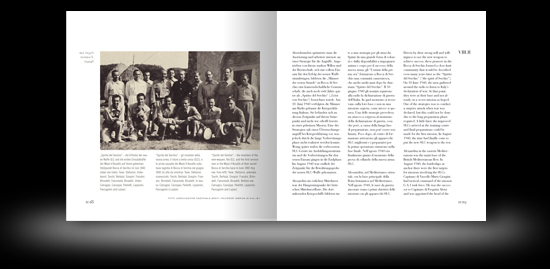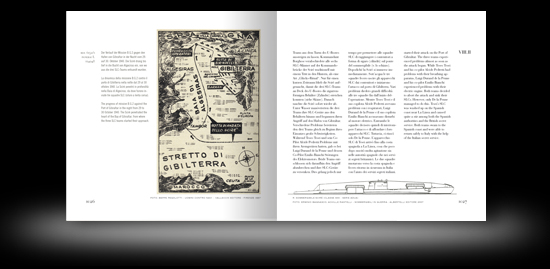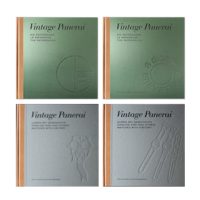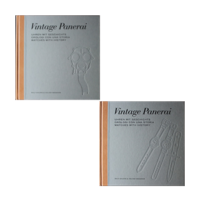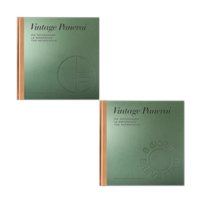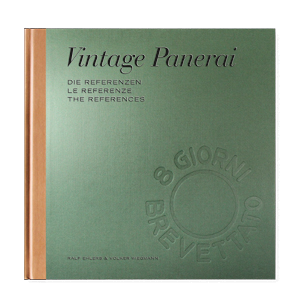Allgemein
Click ‘696’ to find info on “The References” 1930’s-1940’s at a glance
by Volker on Jan.14, 2017, under Allgemein
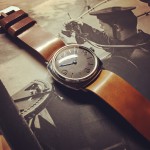 Find information about the content of our book “The References” 1930’s-1940’s by using the “browse by tag” function. The tag 696 is connected with all stories published about the first volume: watches, history, instruments and straps of the 1930’s-1940’s.
Find information about the content of our book “The References” 1930’s-1940’s by using the “browse by tag” function. The tag 696 is connected with all stories published about the first volume: watches, history, instruments and straps of the 1930’s-1940’s.
The photo on the left shows a Ref. 3646 / Type D (featured in chapter II.IV) placed on a historic photo of a cunning tower of a Royal Italian Navy submarine, on which an instrument (aiming device, described as “traguardo di puntamento per il lancio di siluri”) with luminous Radiomir display from Guido Panerai & Figlio can be seen on the left. The firm and close contact with the Royal Italian Navy, which existed many years prior to the start of producing watches, meant that a prerequisite had been established within Panerai: One only uses the best components.
The early References 2533 (chapter I) and 3646 (chapter II) are explained and with rich reference to several variants by their number groups. This overview is complimented by the legendary Mare Nostrum chronograph (chapter III), rare compasses (chapter IV) used in the Second World War and some of the few straps and buckles which rarely survived after more than 70 years (chapter V).
“The References” books are in stock and ready for shipping – just visit our bookstore and enjoy reading soon! [Ralf Ehlers & Volker Wiegmann]
Ref. 3646 watches with disappeared Rolex hallmarks
by Volker on Jan.14, 2017, under Allgemein
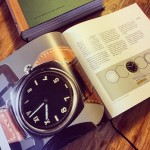 Why do some Ref. 3646 watches come only with a six digit case number embossed on their inner caseback? Where did the Rolex hallmark and reference number go? In which of the seven different number groups of the Reference 3646 is this the case?
Why do some Ref. 3646 watches come only with a six digit case number embossed on their inner caseback? Where did the Rolex hallmark and reference number go? In which of the seven different number groups of the Reference 3646 is this the case?
Our book “The References” 1930’s-1940’s answers these questions in two chapters by measurement results and illustrated cross-sections (page 537-551, 638-639 and 644-645). The coffee table shot on the left shows a Ref. 3646 / Type G with a technical illustration on page 618-619 in chapter II.VII.
Chapter II.V = Reference 3646 / Type E
(featuring four different watches on page 532-573).
Chapter II.VII = Reference 3646 / Type G
(featuring two different watches on page 608-645).
“The References” books are in stock and can be ordered in our bookstore. Enjoy reading!
“kept together by six screws” – the giant GPF 2/56
by Volker on Jan.08, 2017, under Allgemein
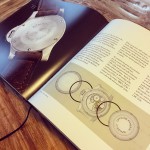 In many respects, the GPF 2/56 set new standards in terms of design at Guido Panerai & Figlio: The casing diameter, now at a stately 60 mm (or 66 mm including the crown-protecting device), made the earlier Panerai watches with their 47 mm casings look small by comparison. This was also the first time a rotating bezel with five-minute increments was used, a luminous reference point at 12 o’clock and three other major indices at 15, 30 and 45 minutes. The inside of the rotating bezel is fixed securely to the casing and caseback with six screws at a distance of 60° on the underside. If the six screws are loosened, it is possible to lift off the caseback, the rotating bezel and the Plexiglas crystal from the watch casing. Unlike earlier Panerai watches, the caseback of the giant GPF 2/56 does not feature a thread but is fixed securely to the casing by the six screws. Compared to the Panerai watches used during the Second World War (bezel and caseback „twisted“ together by their internal thread onto the holding ring of the movement) as well as the watches produced in the 1950’s (bezel pressed onto the casing and caseback with external thread screwed onto the centre of the 47 mm casing).
In many respects, the GPF 2/56 set new standards in terms of design at Guido Panerai & Figlio: The casing diameter, now at a stately 60 mm (or 66 mm including the crown-protecting device), made the earlier Panerai watches with their 47 mm casings look small by comparison. This was also the first time a rotating bezel with five-minute increments was used, a luminous reference point at 12 o’clock and three other major indices at 15, 30 and 45 minutes. The inside of the rotating bezel is fixed securely to the casing and caseback with six screws at a distance of 60° on the underside. If the six screws are loosened, it is possible to lift off the caseback, the rotating bezel and the Plexiglas crystal from the watch casing. Unlike earlier Panerai watches, the caseback of the giant GPF 2/56 does not feature a thread but is fixed securely to the casing by the six screws. Compared to the Panerai watches used during the Second World War (bezel and caseback „twisted“ together by their internal thread onto the holding ring of the movement) as well as the watches produced in the 1950’s (bezel pressed onto the casing and caseback with external thread screwed onto the centre of the 47 mm casing).
While the crown-protecting device was a very prominent, almost “superimposed” addition to the Reference 6152/1, and could only be integrated into the Rolex casing to a certain degree as a result of its construction, the GPF 2/56 clearly shows the “completely seamless integration” of the legendary crown-protecting device.
The coffee table shot on the left shows page 1092 – 1093 in chapter IX.I of our book “The References” 1950’s-1960’s with a photo of the screwed caseback of a GPF 2/56 (left) and an illustration of the construction of the “kept together by six screws” GPF 2/56 (right). Enjoy reading!
The weak spot of the 3646
by Volker on Jan.04, 2017, under Allgemein
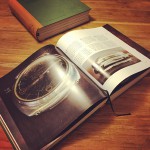 With regard to the evolution of watches from Guido Panerai & Figlio, one particular weak point has been often mentioned that has been improved hugely over time: the strap loops soldered on to the pillow-shaped casing of the Reference 3646. With the Radiomir watch shown here, a Ref. 3646 / Type B with riveted plastic dial, we can take a closer look at precisely this weak point and show an example of a Reference 3646 that was not returned to its original condition after being damaged. The watch shown in the photo on left is described in detail on page 228-237 in chapter II.II of our book “The References” 1930’s-1940’s.
With regard to the evolution of watches from Guido Panerai & Figlio, one particular weak point has been often mentioned that has been improved hugely over time: the strap loops soldered on to the pillow-shaped casing of the Reference 3646. With the Radiomir watch shown here, a Ref. 3646 / Type B with riveted plastic dial, we can take a closer look at precisely this weak point and show an example of a Reference 3646 that was not returned to its original condition after being damaged. The watch shown in the photo on left is described in detail on page 228-237 in chapter II.II of our book “The References” 1930’s-1940’s.
With the experience collected during the Second World War, the aim was primarily to increase the stability of the watches’ lugs. The soldered wire watch loops had been revealed as a weak spot and Guido Panerai & Figlio worked hard to improve them and the result was a success – in shape of the watches of the Reference 6152, 6154, 6152/1 and last but not least the huge GPF 2/56. The lugs of these watches were all created out of the casing itself and no longer soldered on (read also page 723-733 in chapter VI of our book “The References” 1950’s-1960’s) as it was the case with the watches of the Reference 3646.
Naval Heritage – The SLC pilot who later became Commander of South Europe’s Naval Forces
by Volker on Dec.31, 2016, under Allgemein
 He survived the air raid against the transport submarine Iride in August 1940 – the mission G.A.1 against Alexandria failed. He took part on the mission B.G.1 against allied ships in Gibraltar aboard the transport submarine Scirè in September 1940 – but his second mission failed again as the allied ships left the night before for Operation “Menace” – this time the Decima MAS was late…
He survived the air raid against the transport submarine Iride in August 1940 – the mission G.A.1 against Alexandria failed. He took part on the mission B.G.1 against allied ships in Gibraltar aboard the transport submarine Scirè in September 1940 – but his second mission failed again as the allied ships left the night before for Operation “Menace” – this time the Decima MAS was late…
Another four weeks later, on 30 October 1940, he became the first SLC pilot to penetrate a heavily guarded enemy harbour with the new, secret weapon which still had to achive its initial and decisive proof of feasibility: the concept of attacking enemy ships in ports. Unnoticed, in the darkness of the night. Mission B.G.2, even without the success of damaging or sinking an enemy ship, marked the start of a three-year war that took place noiselessly underwater in the Bay of Gibraltar. However, for Gino Birindelli, mission B.G.2 marked the start of a journey through Allied POW camps that would last until early 1944.
In his memoirs Gino Birindelli M.O.V.M. wrote a remarkable sentence: “I could clearly see my left wrist with the big Radiomir watch we used during the action and I saw how the hand moved, time was passing…” In his personal story this was just a very little side note, but it underlined clearly the importance of the waterproof, luminous and reliable Panerai watch he and the men of the Mezzi d’Assalto of the Royal Italian Navy were trusting during their action.
Page 1018 – 1019: The inventors of the SLC, Teseo Tesei and Elios Toschi, together with the first crews which instigated the legendary “Spirito del Serchio” at their secret base at Bocca di Serchio in June 1940 – Gino Birindelli was one of them.
Page 1026 – 1027: The progress of Mission B.G.2 against the port of Gibraltar in the night from 29 to 30 October 1940. The transport submarine Scirè, commanded by Junio Valerio Borghese, penetrated the Bay of Gibraltar, from where the three SLC teams started their approach.
Page 1012 – 1013: A view inside Birindelli’s Ref. 6152/1 with crown-protecting device and Rolex movement. The watch was auctioned at Sotheby’s in May 2014.
In his function as a two-time commander of the “Raggruppamento Subacquei ed Incursori Teseo Tesei” special unit, Gino Birindelli was one of the men who passed on his experiences to the next generation of the naval special unit. When selecting the instruments for the COMSUBIN incursori, watches from Guido Panerai & Figlio were the first choice, even after the Second World War. The fact that Birindelli still possessed a Panerai watch from the era even years after his commando activities whit the COMSUBIN shows the significance and symbolism of a Panerai watch, which must surely have been a sign of military tradition, a menento and a sign of appreciation.
The watch of Admiral Gino Birindelli (1911 – 2008) and the unique story behind his career being Comandante 1a Divisione Navale, Comandante in Capo della Squadra Navale and Comandante Nave Alleato del Sud Europa can be read in the book “The References” 1950’s-1960’s (chapter VIII.II, page 1006 to 1043). Read more on Gino Birindelli also here. Enjoy reading!
Follow us on facebook… thanks for more than 2000 likes!
by autor on Nov.14, 2016, under Allgemein
 Keep in touch with the latest news and activities on Vintage Panerai. Follow us:
Keep in touch with the latest news and activities on Vintage Panerai. Follow us:
https://www.facebook.com/VintagePanerai
[Ralf Ehlers & Volker Wiegmann]
November in Geneva: five watches in two auctions
by Volker on Nov.01, 2016, under Allgemein
 Geneva based auctioneers Phillips and Christie’s will offer five Vintage Panerai watches in their upcoming auctions between 12 and 14 November 2016.
Geneva based auctioneers Phillips and Christie’s will offer five Vintage Panerai watches in their upcoming auctions between 12 and 14 November 2016.
First of the five is lot 82 – a Ref. 6152/1 “Luminor Panerai” with Rolex movement and crown-protecting device in The Geneva Watch Auction: FOUR (session one: 12 November 2016, 6 pm, lots 1-100). Read more about this Ref. 6152/1 in our Watch Point. Lot 152 – a “warbird” in shape of a Ref. 3646 / Type D is the second Vintage Panerai to be auctioned at Phillips (session two: 13 November 2016, 6 pm, lots 101-196). Read more about this “Kampfschwimmer” in our Watch Point. The following lot 153, a Ref. 6154 “Small Egiziano” is the third and last Vintage Panerai watch to be auctioned at Phillips. Read more about this watch in our Watch Point.
[Photo with kindly permission / courtesy of www.phillips.com]
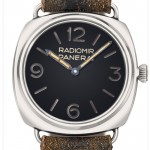 One day later, 14 November 2016, Christie’s is featuring two Vintage Panerai watches in their Sale 1417. The morning session starts at 10 am (lots 1-146) in which a Ref. 3646 / Type B with “Radiomir Panerai” dial and “Xa FLOTMAS” engraving on its caseback will be auctioned (lot 99).
One day later, 14 November 2016, Christie’s is featuring two Vintage Panerai watches in their Sale 1417. The morning session starts at 10 am (lots 1-146) in which a Ref. 3646 / Type B with “Radiomir Panerai” dial and “Xa FLOTMAS” engraving on its caseback will be auctioned (lot 99).
The afternoon session starts at 2 pm (lots 147-236), in which a Ref. 3646 / Type C with “Radiomir Panerai” dial will be up for auction (lot 209). Read more about these two Ref. 3646 watches in our Watch Point.
[Photo with kindly permission / courtesy of www.christies.com]
Watches of the Ref. 3646 / Type B, Type C and Type D are featured in our book “The References” (first volume / 1930’s-1940’s) in chapter II.II-IV.
Chapter VII and VIII.II of “The References” (second volume / 1950’s-1960’s are featuring watches of the Ref. 6154 and Ref. 6152/1. Visit our bookstore for more info.
One reference, seven variations: The 3646 / Type A-G
by Volker on Oct.12, 2016, under Allgemein
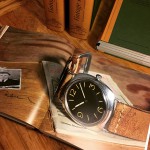 More than two hundred watches of the reference 3646 are registered in our database today. Among all different Vintage Panerai models, the 3646 marks the reference with the most known specimen in our records. In 2009, seven years ago, 143 recorded watches were featured in the first (sold out) edition of our book “The References”. Within the entire serial number sequence of the reference 3646, we differentiate between seven different variations (3646 / Type A-G).
More than two hundred watches of the reference 3646 are registered in our database today. Among all different Vintage Panerai models, the 3646 marks the reference with the most known specimen in our records. In 2009, seven years ago, 143 recorded watches were featured in the first (sold out) edition of our book “The References”. Within the entire serial number sequence of the reference 3646, we differentiate between seven different variations (3646 / Type A-G).
In our new book “The References” 1930’s-1940’s the watches of the entire reference 3646 are featured in chapter II with more than six hundred pages in the chapters II.I-II.VII following an intro on page 40-49. The seven different variations can be found in our reference quickfinder on page 14-20. The coffee table shot on the left shows one of seven specimen of the Ref. 3646 / Type C, introduced on page 322-349. Read also the extensively documented story of Helmut Rösel, first owner of this watch, in chapter IX of our book “History2”. Each of the seven variations of the reference 3646 are published here:
Chapter II.I = Reference 3646 / Type A
(featuring two different watches on page 50-169).
Chapter II.II = Reference 3646 / Type B
(featuring four different watches on page 170-247).
Chapter II.III = Reference 3646 / Type C
(featuring seven different watches on page 248-397).
Chapter II.IV = Reference 3646 / Type D
(featuring nine different watches on page 398-531).
Chapter II.V = Reference 3646 / Type E
(featuring four different watches on page 532-573).
Chapter II.VI = Reference 3646 / Type F
(featuring two different watches on page 574-607).
Chapter II.VII = Reference 3646 / Type G
(featuring two different watches on page 608-645).
 Aside numerous photos and technical illustrations of these 30 different watches, we have also published several yet unreleased historic photos of frogmen wearing watches of the reference 3646 during the Second World War.
Aside numerous photos and technical illustrations of these 30 different watches, we have also published several yet unreleased historic photos of frogmen wearing watches of the reference 3646 during the Second World War.
One of these rare photos shows “Kampfschwimmer” Werner Bullin on page 275 in chapter II.III, wearing his 3646 with “Radiomir Panerai” dial. The coffee table shot on the left shows this photo which was taken at Piazza San Marco / Venice in summer 1944. Another rare photo has been introduced earlier here. Read the extensively documented story of Werner Bullin and Heinz Günter Lehmann over the 75 pages of chapter I in our book “History1”.
The new “The References” books can be ordered only in our bookstore. Enjoy reading!
Three columns of the Panerai DNA in auction at Phillips
by Volker on Sep.25, 2016, under Allgemein
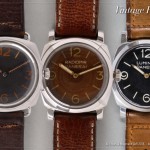 November will bring remarkable Vintage Panerai watches to auction. Phillips announced to have three columns of the Panerai DNA in their Geneva Watch Auction: FOUR.
November will bring remarkable Vintage Panerai watches to auction. Phillips announced to have three columns of the Panerai DNA in their Geneva Watch Auction: FOUR.
A German “Kampfschwimmer” Ref. 3646 / Type D, used in the Second World War, has been introduced in our Watch Point here. This warbird with anonymous sandwich dial is one of the very few watches with original strap and pin buckle – unpolished and with quite some patina.
The “Maserati” amongst Vintage Panerai references because of its flat, elegant and streamlined case is introduced in our Watch Point here. This rare Ref. 6154 “Small Egiziano” with brown “Radiomir Panerai” dial is up for auction being a “collectors’ set”, including a Guido Panerai & Figlio depth gauge, underwater torch and replacement strap with “GPF – Mod. Dep.” pin buckle.
The third column of the Panerai DNA in the Phillips Geneva Watch Auction: FOUR is a Ref. 6152/1 “Luminor Panerai” with Rolex movement and the legendary crown-protecting device from Panerai – an icon of the brand. Read more about this watch in our Watch Point here.
[Photos with kindly permission / courtesy of www.phillips.com]
One more 3646 / Type D with brass dial surfaced in the UK
by Volker on Sep.18, 2016, under Allgemein
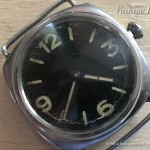 Introducing another piece of the puzzle – and one more surfaced in the United Kingdom: a Ref. 3646 / Type D with black painted brass dial and rare “Kampfschwimmer” engraving with initials of the first owner on its outer caseback. After more than 70 years the watch changed ownership once again and recently found a good new home at a Panerai collector from Germany, who provided the photo shown on the left.
Introducing another piece of the puzzle – and one more surfaced in the United Kingdom: a Ref. 3646 / Type D with black painted brass dial and rare “Kampfschwimmer” engraving with initials of the first owner on its outer caseback. After more than 70 years the watch changed ownership once again and recently found a good new home at a Panerai collector from Germany, who provided the photo shown on the left.
The watch has been added into our database in March 2016 and comes with flat bezel (a typical feature of the watches with flat dials), onion shaped “Brevet +” crown (Type 11) and Rolex Cal. 618 / Type 1 movement. The watch has never been polished and has still its original plexi, showing the typical traces of aging. The inner caseback is signed with the Rolex SA hallmark, reference and case number. A similar 3646 / Type D watch with flat bezel and black painted brass dial will be auctioned in Glasgow on September 23rd, 2016 at Great Western Auctions.
A Ref. 3646 / Type D watch with black painted brass dial is featured in our book “History1” in chapter III together with the history of its first owner, a German “Kampfschwimmer” who provided us very interesting information about his service, training and how some of these Panerai watches “changed ownership” during the time when he was a POW (prisoner of war) in the summer of 1945 (page 206-207).
Watches of the Reference 3646 / Type D are also featured in our new book “The References” 1930’s-1940’s in chapter II.IV (page 398-531) including a historic photo of a German “Kampfschwimmer” wearing a 3646 with brass dial on page 475.

